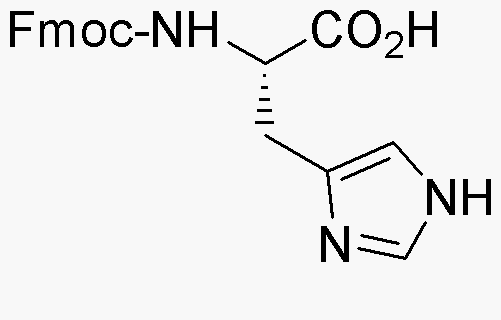Na-Fmoc-L-histidine is widely utilized in research focused on
- Peptide Synthesis: This compound serves as a protective group in the synthesis of peptides, allowing for the selective modification of amino acids. Its stability under various conditions makes it a preferred choice for researchers in organic chemistry.
- Drug Development: In pharmaceutical research, it plays a critical role in the design of histidine-containing compounds, which are essential for developing new drugs targeting various diseases, including cancer and metabolic disorders.
- Bioconjugation: Na-Fmoc-L-histidine is used in bioconjugation processes, where it helps in attaching biomolecules to surfaces or other molecules, enhancing the efficacy of drug delivery systems.
- Protein Engineering: This compound is valuable in protein engineering, allowing scientists to modify proteins at specific sites, which can lead to the development of proteins with improved stability and activity.
- Research on Enzyme Activity: It aids in studying enzyme mechanisms by providing a histidine residue that can participate in catalytic processes, helping researchers understand enzyme function and develop inhibitors.
General Information
Properties
Safety and Regulations
Applications
Na-Fmoc-L-histidine is widely utilized in research focused on
- Peptide Synthesis: This compound serves as a protective group in the synthesis of peptides, allowing for the selective modification of amino acids. Its stability under various conditions makes it a preferred choice for researchers in organic chemistry.
- Drug Development: In pharmaceutical research, it plays a critical role in the design of histidine-containing compounds, which are essential for developing new drugs targeting various diseases, including cancer and metabolic disorders.
- Bioconjugation: Na-Fmoc-L-histidine is used in bioconjugation processes, where it helps in attaching biomolecules to surfaces or other molecules, enhancing the efficacy of drug delivery systems.
- Protein Engineering: This compound is valuable in protein engineering, allowing scientists to modify proteins at specific sites, which can lead to the development of proteins with improved stability and activity.
- Research on Enzyme Activity: It aids in studying enzyme mechanisms by providing a histidine residue that can participate in catalytic processes, helping researchers understand enzyme function and develop inhibitors.
Documents
Safety Data Sheets (SDS)
The SDS provides comprehensive safety information on handling, storage, and disposal of the product.
Product Specification (PS)
The PS provides a comprehensive breakdown of the product’s properties, including chemical composition, physical state, purity, and storage requirements. It also details acceptable quality ranges and the product's intended applications.
Certificates of Analysis (COA)
Search for Certificates of Analysis (COA) by entering the products Lot Number. Lot and Batch Numbers can be found on a product’s label following the words ‘Lot’ or ‘Batch’.
Número de catálogo
Número de lote/lote
Certificates Of Origin (COO)
This COO confirms the country where the product was manufactured, and also details the materials and components used in it and whether it is derived from natural, synthetic, or other specific sources. This certificate may be required for customs, trade, and regulatory compliance.
Número de catálogo
Número de lote/lote
Safety Data Sheets (SDS)
The SDS provides comprehensive safety information on handling, storage, and disposal of the product.
DownloadProduct Specification (PS)
The PS provides a comprehensive breakdown of the product’s properties, including chemical composition, physical state, purity, and storage requirements. It also details acceptable quality ranges and the product's intended applications.
DownloadCertificates of Analysis (COA)
Search for Certificates of Analysis (COA) by entering the products Lot Number. Lot and Batch Numbers can be found on a product’s label following the words ‘Lot’ or ‘Batch’.
Número de catálogo
Número de lote/lote
Certificates Of Origin (COO)
This COO confirms the country where the product was manufactured, and also details the materials and components used in it and whether it is derived from natural, synthetic, or other specific sources. This certificate may be required for customs, trade, and regulatory compliance.


